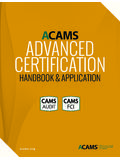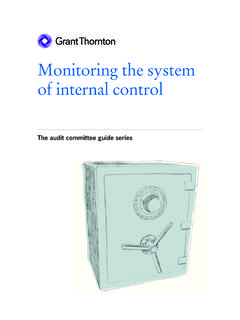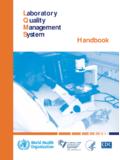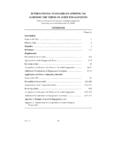Transcription of Internal Auditor Course Handbook - AAVLD
1 American Association for Laboratory Accreditation TRAINING COURSEI nternal AuditingCourse Course Notes 2012 American Association for Laboratory Accreditation No portion of these notes may be reproduced in any form without the written permission of the copyright Auditor Course Handbook A2LA Training Rev Page i of iii Table of Contents Section ..Page Introduction ..1 Course Description .. 1 Course Learning Objectives .. 1 Completing the Course .. 1 Course Content .. 1 Course Grading .. 2 Chapter 1 QMS and Internal Audit Process ..3 Learning Objectives .. 3 QMS and the Operations of a Laboratory .. 3 The Integration of Business Functions .. 3 The Continual Improvement Process .. 4 From Identification to Action .. 5 How Does Internal Audit Help The laboratory? .. 5 Standard audit requirements.. 6 Overview of the Onsite Audit Process .. 6 Process and Procedural Audits.
2 6 Different types of audits within a laboratory QMS.. 7 The conduct of laboratory Internal auditors .. 7 Laboratory Internal Auditor Skills and Personal Attributes .. 8 Laboratory Internal Auditor Appointments .. 8 Auditor Involvement in Resolving Findings .. 8 Chapter 2 Planning Internal Audits ..10 Learning Objectives .. 10 The Internal Audit Cycle.. 10 Ensuring the System is Ready .. 11 Planning Internal 11 Relationships .. 12 Implementing the Internal Audit Program .. 13 Presenting the Plan during Opening Meetings .. 15 Exercise No. 1 Planning an Audit for Laboratory .. 16 Learning Objectives: .. 16 Exercise Objectives: .. 16 Exercise Deliverables 10 minutes per group .. 16 Presentation and Group Discussion 30 minutes .. 16 Chapter 3 Conducting an Internal Audit ..20 Learning Objectives .. 20 Document Review .. 20 Opening Meetings.
3 20 Auditor Approaches .. 21 Responsibilities for Conduct and Communication .. 21 Communication Styles .. 22 Conducting Interviews .. 22 Responding to Conflict and Challenges .. 22 Recording Audit Observations .. 23 During the Document Review (System Audit) .. 23 Internal Auditor Course Handbook A2LA Training Rev Page ii of iii During the Onsite Audit (Conformance Audit) .. 23 Wash up Meetings .. 23 Exercise No. 2 INTERVIEWS .. 24 Learning Objectives: .. 24 Exercise Objectives: .. 24 Exercise Preparation 10 minutes .. 24 Exercise Deliverables 10 minutes per group .. 24 Presentation and Group Discussion 30 minutes .. 24 Chapter 4 Writing Findings ..27 Learning Objectives .. 27 Audit Findings .. 27 Three Components .. 27 Types of Evidence .. 27 How much Evidence? .. 27 Internal Audit Report .. 28 Internal Audit Report Content .. 28 Internal Audit Report Structure.
4 28 The Closing Meeting .. 36 Closing Meeting Agenda .. 36 Team Debriefing .. 36 Exercise No. 3 AUDIT REPORTS .. 37 Learning Objectives: .. 37 Exercise Objectives: .. 37 Exercise Preparation 60 minutes .. 37 Exercise Deliverables 15 minutes per group .. 37 Presentation and Group Discussion 30 minutes .. 37 Internal Auditor Course Handbook A2LA Training Rev Page 1 of 53 Introduction Course Description This Course is for accredited laboratory staff: Who are employed in an quality position, or Who wish to participate in the Internal audit processes of their laboratory. Laboratories are accredited in order to meet regulator and client competence requirements. Internal audits provide laboratory staff with the very best information on the state of the quality management system (QMS) that is supposed to support them in their work and facilitate the production of technically valid results.
5 This Course will provide information to laboratory staff seeking to participate in the Internal audit process so that they may be able to identify those conditions that either impede the competent work of the laboratories or provide unacceptable risk to the business. Course Learning Objectives The Course will assist you to: understand the basics of a continual improvement process; understand the Internal audit cycle; understand the responsibilities for the preparation, planning, conduct and close out of Internal audits; conduct interviews of auditees; record observations and audit evidence; document audit findings; prepare an audit report, and conduct a closing meeting. Completing the Course The Course material is broken down into 4 chapters. Within each chapter, specific objectives are listed as well as instructions on how to complete each chapter.
6 Directions are provided to guide you through the readings, other reference materials, and work to be completed. Course Content The syllabus for this Course is as follows. Chapter 1 The Internal audit process QMS support to laboratory operations Continual improvement within laboratories Internal audit processes Internal Auditor behaviours Chapter 2 Planning Internal audits Internal audit planning Audit planning exercise Chapter 3 Meetings and interviews Document review Internal Auditor Course Handbook A2LA Training Rev Page 2 of 53 Meetings Auditor behaviours Recording observations Chapter 4 Writing findings Components of a finding Audit report content and structure Presenting audit reports Chapter 5 Closing out findings Who does it Determining the need for Root Cause Analysis Implementing the Solution Follow up for Effectiveness Course Grading Participants are graded on their participation
7 During the exercises and a quiz at the end of the day. 70% is required in order to pass this Course . All participants are eligible to receive a Certificate of Participation. Participants who wish to receive a Certificate of Successful Completion must do two things: Participate in the discussions in class, and Pass the quiz at the end of the Course . Internal Auditor Course Handbook A2LA Training Rev Page 3 of 53 Chapter 1 QMS and Internal Audit Process Learning Objectives Upon completion of this chapter, you should be able to: appreciate how QMS is meant to assist the laboratory in its operations; understand the basics of a continual improvement process, and understand why Internal audits are important to the laboratory. QMS and the Operations of a Laboratory The Integration of Business Functions This diagram shows where QMS provides support to the overall laboratory business.
8 PROCESS CONTROL quality Control (QC) quality MANAGEMENT SYSTEMS (QMS) Includes all functions that influence the validity of technical results All business operations functions All management and administrative functions All finance functions All HR functions All purchasing and contract review functions All marketing and communications functions All maintenance functions Pre - Preparation Test, Calibration. Data Validation Post Sales Inspection, CONTROL OF DATA quality Assurance (QA) Contact Sampling Reporting FeedbackInternal Auditor Course Handbook A2LA Training Rev Page 4 of 53 The Continual Improvement Process If perfection in a testing laboratory was to be described, and this perfection was based on the principles behind ISO/IEC 17025:2005, the description would probably look like this: We produce consistent results, day after day, within the 95% confidence region at the specified uncertainties.
9 Drawing by Iutta Waloschek. From the website of the University of St. Andrews, Scotland. ~history/ The authors of ISO/IEC 17025:2005 envisioned laboratories to be able to consistently produce results at specified uncertainties, within the 95% confidence region, day after day after day after boring day. In the world of laboratories, boring stability means TRUST. This can be considered the state of perfection for a testing lab or the goal of a continual improvement program. The thing that most commonly interferes with a business unit s ability to attain this state of perfection is change: change in personnel, change in structure, change in equipment, change in procedure, change in environment etc. The thing that best supports attaining such a state of perfection is stability. No one can prevent change.
10 However, our management system (health, safety, environmental and quality ) can help us manage it. It provides a systematic method of identifying and addressing those things that would bring about some change and eventually impede the consistent production of valid results. In a good business unit, continual improvement is mostly about the management of change. The consistency facilitated by laboratory QMS also promotes safe working conditions. The single greatest safety enhancement an organisation can implement is to provide a stable, supportive environment to its own people and allow them to identify and address the undesirable conditions that are impediments to safety and to quality . Internal Auditor Course Handbook A2LA Training Rev Page 5 of 53 From Identification to Action Clause Governing Reference When the deviation occurs Today Tomorrow?







